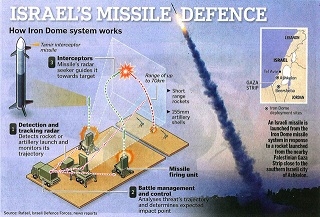Is Iron Dome the Maginot Line?
An interesting article in The New York Times, “Israel’s Antimissile System Attracts Potential Buyers,” somewhat deflates the widespread praise for the performance of Israel’s Iron Dome batteries in the recent fighting with Gaza. Israel claims that Iron Dome was 85 percent effective, but the numbers deserve some examination. All the claims for the effectiveness of the system are derived from the Israeli government, which would very much like to sell Iron Dome to other countries. South Korea, whose capital Seoul is close to the North Korean border, has been identified as a possible buyer.
The 85 percent effective number means that the missiles launched by Iron Dome either destroyed or deflected incoming missiles 85 percent of the time, but a Ministry of Defense account on November 21st demonstrates otherwise: 1,382 rockets fired from Gaza struck Israel, with another 389 intercepted by Iron Dome. Other estimates indicate that 70 percent of Gazan missiles and rockets landed in Israel without being intercepted, which might suggest that the Israeli government is cooking the books to make the system appear more effective than it is both to intimidate the Palestinians and to encourage foreign sales.
The Israeli government response to those numbers has been to claim that most of the hits were on parts of the country not protected by Iron Dome and the U.S. has gone along with that narrative, apparently agreeing to buy still more launchers to cover nearly all of Israel. But a civilian expert cited in the Times article notes that he has seen no photographic evidence that the Gazan missiles were actually brought down by Iron Dome. The missiles and rockets fired from Gaza were largely homemade with crude guidance and stabilization systems and subject to failure without the intervention of any defensive system. Just because an Iron Dome anti-missile-missile detonated does not necessarily mean that it destroyed anything when it did so.
The Iron Dome system works by picking up an incoming missile on radar, using sophisticated tracking software to predict whether it will hit a populated area, and then launching a counter-missile to intercept. The actual destruction of the incoming missile is theoretically accomplished through an exploding warhead that releases hundreds of flechettes that destroy the attacker. When that occurs, the destroyed incoming missile should be perforated by the shrapnel, but that has not been evident in any photos. Since Israel has a vested interest in promoting the success of the system, any photos produced by the government from this point on would have to be considered suspect, cherry picked to make a case.
Israel’s missile defenses might, in fact, be of questionable value in terms of cost effectiveness. Consider for a moment the economics of Iron Dome. There are currently five operational units that are towed to the sites where are they deployed. They have cost $50 million each. Israel eventually wants to deploy thirteen of them, all paid for by the US taxpayer. In the recent fighting, the Iron Dome units fired an estimated $25-30 million worth of anti-missile missiles, with a per unit cost of $50,000. The Gazan weapons were largely homemade though sometimes using Iranian avionic parts smuggled in and had no infrastructure costs for the launchers. Most were so-called Qassams, lacking sophistication but costing about $100 to construct. So on a one-to-one basis it costs $50,000 per missile fired from a $50 million launcher to defeat something that might cost $100 to build. And as for the nature of the threat itself, during 2011 missiles and rockets launched from Gaza managed to kill no one in Israel.
___________________________________________________________________________________
Philip Giraldi is a recognized authority on international security and counterterrorism issues. He became famous for claiming in 2005 that the USA was preparing plans to attack Iran with nuclear weapons in response to a terrorist action against the US, independently of whether or not Iran was involved in the action. He is a former CIA counter-terrorism specialist and military intelligence officer who served eighteen years overseas in Turkey, Italy, Germany, and Spain. He was Chief of Base in Barcelona from 1989 to 1992 designated as the Agency’s senior officer for Olympic Games support. Since 1992, Phil Giraldi has been engaged in security consulting for a number of Fortune 500 corporate clients. He is currently President of San Marco International, a consulting firm that specializes in international security management and risk assessment, and also a partner in Cannistraro Associates, a security consultancy located in McLean, Virginia. Phil was awarded an MA and PhD from the University of London in European History and holds a Bachelor of Arts with Honors from the University of Chicago. He speaks Spanish, Italian, German, and Turkish.
___________________________________________________________________________________
Photo: Jack Guez/AFP via Getty Images
Article published here: American Conservative
URL: http://www.a-w-i-p.com/index.php/2012/12/04/is-iron-dome-the-maginot

























